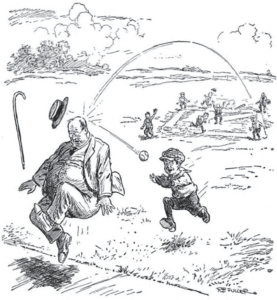Shea Stadium is not Eden, and the picture of Tom and Nancy Seaver leaving its graceless precincts in tears did not immediately remind me of the Expulsion of Adam and Eve in the Brancacci Chapel. And yet, absorbing the feelings generated by Seaver’s departure from New York led me to the kind of inflated cogitation that links Masaccio and the Mets, if only because the feelings were so outsized and anguished and intense.
The late Sixties and early Seventies were celebrated or execrated for many things besides someone being able to throw a baseball consistently at ninety-five miles per hour. Yippies yipped, flower children blossomed and withered, America was being greened, by grass and by rock and by people who peddled them. This was a pastoral time, and it would, like all pastorals, turn sere, but for three or four years, while Seaver was gaining control over a block of space approximately three feet high, eighteen inches wide, and sixty feet six inches long, many other of America’s young were breaking loose. Here are, I think, the origins of the Seaver mystique in New York, in the young Californian who brought control, in the youth who came east bearing—indeed, embodying—tradition.
Seaver was authentic; neither a goody two shoes nor a flash in the pan, he matured into the best pitcher in baseball. He was a national symbol, nowhere more honored than in New York, and in New York never more loved than by the guy who seemed in every other respect Seaver’s antithesis, the guy who would never give a sucker an even break, who knew how corrupt they all were, who knew it was who you knew that counted, who knew how rotten it all really was—this guy loved Seaver because Seaver was a beautiful pitcher, a working guy who got his reward; Seaver was someone who went by the rules and made it. The guy loved Seaver because Seaver did not have to be streetwise.
 In bars in Queens, in clubs in the Bronx, in living rooms in front of Channel Nine in Suffolk and Nassau, out on Staten Island, everywhere, but particularly in the tattered reaches of Shea Stadium, they loved him for many things, but above all because he never thought he had to throw at anybody’s head. They loved it in him, and in that act sought it in themselves.
In bars in Queens, in clubs in the Bronx, in living rooms in front of Channel Nine in Suffolk and Nassau, out on Staten Island, everywhere, but particularly in the tattered reaches of Shea Stadium, they loved him for many things, but above all because he never thought he had to throw at anybody’s head. They loved it in him, and in that act sought it in themselves.
None of this reasoning, if such it is, would appeal to the dominant New York baseball writers, who have used the Seaver trade as a casus belli; nor to M. (for, I think, Moralistic) Donald Grant, chairman of the board of the Mets, who would quickly tell us that Seaver wanted too much money, meaning by that something he would never say aloud but would certainly formulate within himself—that Tom wanted too much. Tom wanted, somehow, to cross the line between employee and equal, hired hand and golf partner, “boy” and man. He believed in the rules, in this game governed by law; if you were the best pitcher in baseball, you ought to get the best salary of any pitcher in baseball; and money—yes, money—ought to be spent so baseball’s best pitcher would not have to work on baseball’s worst-hitting team.
Tom Seaver felt about the Mets the way the guy from Astoria felt about Seaver—he loved them for what they stood for, and he wanted merit rewarded and quality improved. The irony is that Seaver had in abundance precisely the quality that Grant thinks he values most—institutional loyalty, the capacity to be faithful to an idea as well as to individuals.
The fan understood this and was devastated when his understanding and Seaver’s principle were not honored. The anguish surrounding Seaver’s departure stemmed from the realization that the chairman of the board and certain newspaper columnists thought money was more important than loyalty, and the fury stemmed from the realization that the chairman and certain writers thought everybody else agreed with them, or ought to.
The day after Seaver was exiled to Cincinnati by way of Montreal, a sheet was hung from a railing at Shea bearing the following legend: i was a believer but now we’ve lost seaver.
From “Tom Seaver’s Farewell,” which appeared in the September 1977 issue of Harper’s Magazine.































































































